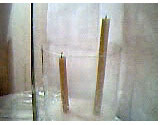


|
Home-made extinguisher
Science at Home |
||
|
Materials
|
Compounds
|
Videos: download.avi (358 KB)
Pictures: 

|
|
Procedure
1. Place two candles of different sizes in the smaller jar. (fix the candles with its own wax. The smallest jar can be replaced by a dessert plate) 2. Add sodium bicarbonate to the smallest jar. 3. Place the smallest jar inside the largest. 4. Pour a glass of vinegar to the sodium bicarbonate. 5. As you can verify, the vinegar begins to react with the sodium bicarbonate. 6. Observe which candle will extinguish first. The smaller or the bigger? |
||
|
Why?
The combustion is a result of the reaction of the oxygen with other substances. The usual extinguisher works removing one of the essential ingredients for the combustion - the oxygen. In the present experiment, the reaction between the sodium bicarbonate and the acetic acid (vinegar) produces carbon dioxide. The carbon dioxide is a colorless gas, with no smell and denser than air. As the carbon dioxide forms, it starts to occupy the bottom of the jar. In a certain instant, the level of carbon dioxide passes the height of the smallest candle, leaving not enough oxygen for the combustion, extinguishing it. After, the carbon dioxide level increases and reaches the height of the bigger candle, extinguishing it equally. |
||
No part of this website can be reproduced without previous authorization. Please inform me if there is any problem with the website. |